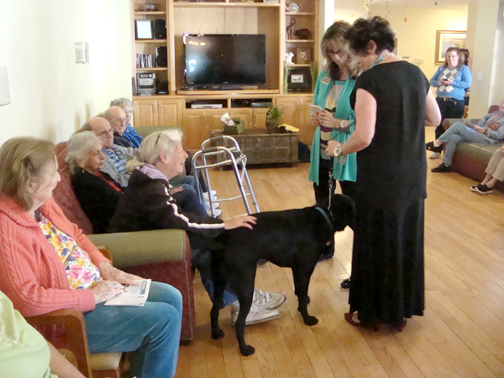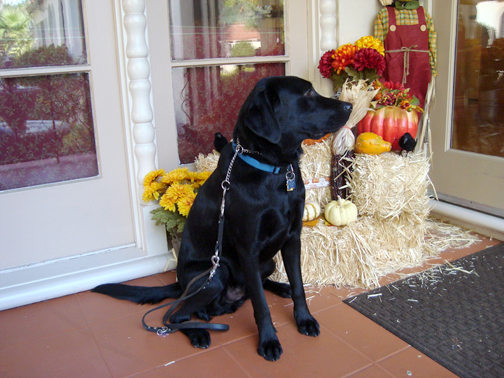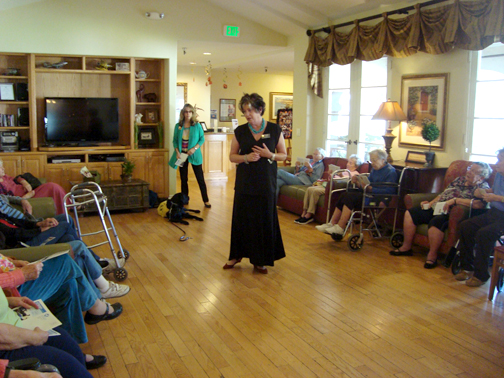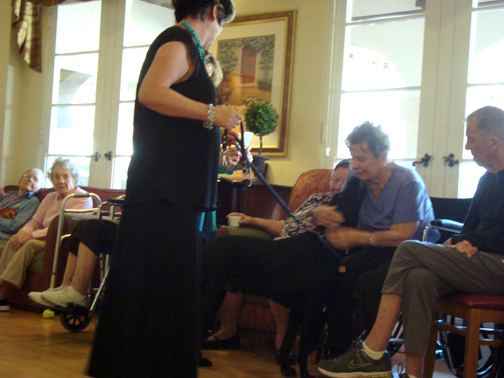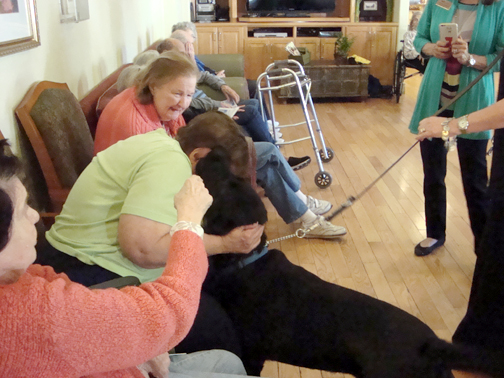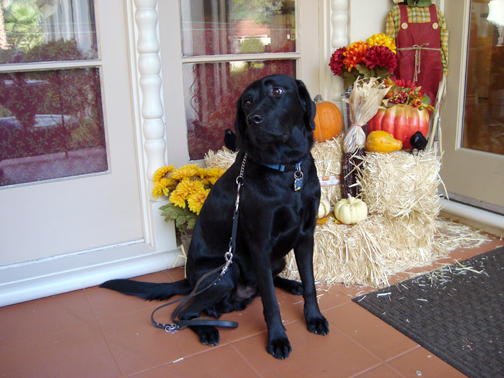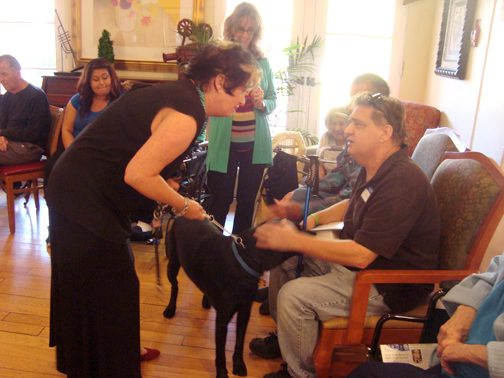
Guide Dogs of America volunteer Judy Reilly introduces Captain, an in-training Labrador, to residents of Foothill Retirement Home in Tujunga.
By Jason KUROSU
Captain, a 16-month-old black Labrador, worked hard on a recent Wednesday afternoon, even though much of his work time was spent lying on the floor of the Foothill Retirement Home in Tujunga.
“Believe it or not, he’s working,” said his trainer, Judy Reilly, a volunteer with Guide Dogs of America.
Wearing his yellow guide dog-in-training jacket, Captain demonstrated discipline while Reilly introduced him to the residents of the Foothill Retirement Home. Reilly’s presentation explained the training regimen that Captain and other dogs undergo to become fully trained guide dogs for the blind and visually impaired.
Reilly estimated that 85% of the dogs used by Guide Dogs of America are Labradors like Captain, because they are “very adaptable and easygoing. That’s very important because there are going to be a lot of changes in this dog’s life.”
Sylmar-based Guide Dogs of America trains and provides dogs for those in need, free of charge and funded through donations from various organizations and individuals. The cost for raising a guide dog team is $42,000, though the training, harness and dog are made available without cost to the blind or visually impaired individual.
The training is a two-year endeavor, which sends the dog home with any of Guide Dogs of America’s 350 volunteer puppy raisers like Reilly. The volunteers take in the dogs at about seven to eight weeks of age and commence the training, from simple commands which emphasize self control and basic obedience to socialization, which involves taking the puppy to many different places with the puppy raiser.
“These puppies come with us everywhere we go – grocery stores, restaurants, movies, basketball games,” said Reilly. “We do that because I have no idea who this dog will be matched up with. It could be a college student at UCLA. It could be a retired farmer in Iowa. It could be a Wall Street banker. I have no idea, so I have to prepare this puppy and expose him to as many things as I can think of.”
After roughly 18 months, the dogs receive formal training at the school in Sylmar where they learn more complex guide dog commands. This training comes from certified guide dog instructors for a period of six to nine months.
Here, dogs must also prove that they are not only physically and medically fit, but also not susceptible to “spooking,” or being sensitive to sounds, as well as a host of otherwise minor issues that are not optimal for guide dogs.
After five months, the dogs that make it this far are deemed “class ready” and are then matched up with prospective students. To qualify, students must be legally blind, have mobility training and be physically able to handle a dog. There is no age restriction that would deem a prospective student too young or too old.
Students from the U.S. or Canada are flown free of charge to the facility in Sylmar, where Guide Dogs of America’s dormitory holds up to 10 students at any time for a 28-day training session with their guide dog.
“It’s not just a question of training the dog. They’ve got to train the person that is going to be matched up with this dog as well,” Reilly explained.
She described the relationship between the guide dog and its owner as that of a pilot and the navigator or co-pilot, in which the blind person commands the dog to bring them to their destination, but the dog is the one navigating and guiding.
One of the more complicated capabilities a guide dog must possess is a trait known as “intelligent disobedience.” Dogs are trained to stop at any change of terrain, including going from sidewalks to streets, concrete to grass, etc. After the dog stops, the blind person will listen and then give the command to move, but the dog will disobey if there is an unexpected hazard.
“On the one hand, this dog needs to be able to obey what it’s told,” Reilly said. “But on the other hand, if it’s going to put the person in danger, it will not do it. It will disobey.”
Guide dogs that become particularly accustomed to their owners can also learn their owners’ usual landmarks in their neighborhoods, including bus stops and medical offices. Reilly spoke of one guide dog that could take his owner to two separate stops in one medical building, each on separate floors of the building and with the offices in opposite directions, upon exiting the elevator.
Reilly estimated that it takes about six months to a year before a guide dog can learn their owner’s habits to this degree.
“It’s a remarkable partnership,” she said.
Reilly wanted to stress that though the dogs have a lot of responsibility and must work hard it was not a burden to please their owner.
“It’s important to realize that this is not a hardship for these dogs. They like it,” she said. “Half of these dogs will not make it as guide dogs. It takes a very special dog to be a guide dog. The main criterion is that they have to want to do it.”
Reilly also noted “the dogs are not working 24 hours a day. Blind people don’t need help getting around their own house. Once the dog gets the person from one point to another point, he’s done his job and the harness comes off.”
Part of the training involves wearing a yellow jacket at all times, which works both to identify its status as a guide dog to the general public as well as get the dogs accustomed to the feeling, as later they will be fitted with harnesses.
“When they have their jacket on, they are working,” Reilly said with emphasis towards Captain, who struggled at times to stay, often wanting to approach people during his shift.
“If [Captain] didn’t have the jacket on, he’d be wandering around, saying hi to everyone,” she said.
Indeed, the jacket did eventually come off and Captain was finally able to greet the seniors of Foothill Retirement the way he’d been resisting throughout the entire afternoon, earning a thorough reward for an honest day’s work.
Captain will be attending Guide Dogs for America’s school for formal training in January.

